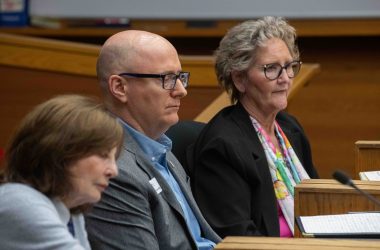
The city of Salem’s initial response to cyanotoxins breaching the water supply this summer caused a frenzy, an independent report found.
The 34-page report, conducted by Ohio-based Novak Consulting Group, found that the city focused too much on sensational messaging and not enough on getting clean water to residents. However, it also found staff were incredibly quick in working to treat the water and end the health risk.
While Salemites were ultimately unharmed by the toxins, the city “failed to anticipate the impact that it would have on the public, or on public trust in city government,” the report stated.
“The result was that the advisory became a communications crisis,” the report said.
The report echoes concerns made last week by Mayor Chuck Bennett, who told the Salem Reporter that city staff did not help people understand the risks and did not have an effective plan in place.
City Manager Steve Powers agreed with the report’s assessment.
“We certainly stumbled in our communication of the first advisory, which led to the responses provided by the state and the assistance we received from Marion County,” Powers told Salem Reporter. “I think it’s accurate for the report to really highlight the communication aspect and the crisis it created.”
The city of Salem first discovered cyanotoxins – commonly known as blue-green algae – in its water supply May 25. If heavily consumed, the toxins can impact vulnerable populations such as small children, the elderly and pregnant or nursing women, according to the Environmental Protection Agency.
Four days later, the city released a message headline “DO NOT DRINK THE TAP WATER.” That message was accompanied by one from the state Office of Emergency Management alerting the public to a “civil emergency” and to “prepare for action.”
Confusion and panic, as well as a dash for grocery store shelves for bottled water, ensued. Gov. Kate Brown soon declared a state of Emergency and National Guard troops were brought in to distribute bottled water.
Much of that reaction, according to Novak Consulting Group’s interviews with staffers, city leaders and other stakeholders, stemmed from the city’s failure “to anticipate how much of an impact the advisory would have on the public.”
A lack of communication underscores most of the report’s criticisms. Employees interviewed by Novak investigators said the issue was born from a culture that put more value on technical skills than on the ability to communicate.
Investigators also found city staff felt they weren’t given clear direction by the Oregon Health Authority, that the Salem-Keizer School District “sent out information too early” and that Marion County and the Office of Emergency Management erred in sending out the “civil emergency” message.
As Bennett mentioned, the report noted that elected officials felt they weren’t told soon enough and that it appeared the city – as well as residents – were unprepared.
“For example, the city did not have any potable water tanks available during the advisory and less than 10 percent of residents had any water stored,” the report said.
The report did applaud the city’s actions after the advisory. The report said many were impressed by how quickly staff mobilized to bring in powder-activated carbon to treat the water.
The city first lifted its drinking water advisory June 2, but then reinstated it June 6 after high toxin levels returned in the water supply. That second advisory remained in place until July 3.
Powers, whose office authorized the report July 20 and paid $18,600 for it, told Salem Reporter the staff will do better at getting its message out, such as engaging on social media more clearly and ensuring Spanish speakers are better informed.
As city manager, Powers said he ultimately takes responsibility for the actions.
“I work for city council. I’m accountable for the organization. I’m the only employee that the city council hires, so yes, I’m accountable,” he said.
Besides improving communication, the city recently bought its own water-testing equipment so it no longer has to send water samples to Ohio, which took days. The Public Works Department also hopes to pitch to city council a $40 million water treatment plant that would use ozone, an oxidizing gas, to disinfect the water at Geren Island.
“We’re not done. We got a lot of work to do to maintain the quality of the water and the confidence of the public, and our water customers, in the drinking water,” Powers said.
Have a story tip? Contact reporter Troy Brynelson: [email protected] or 541-357-6190.









